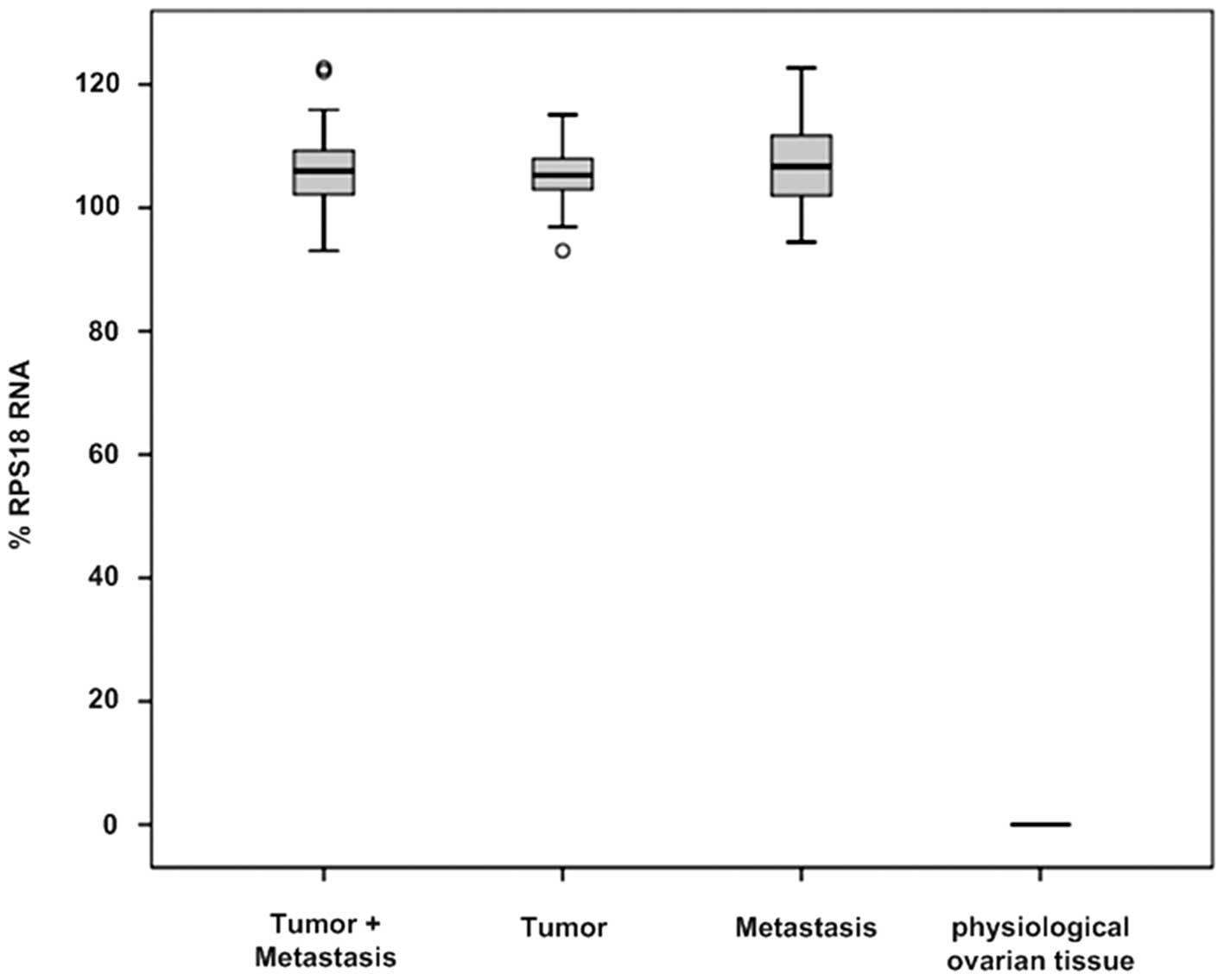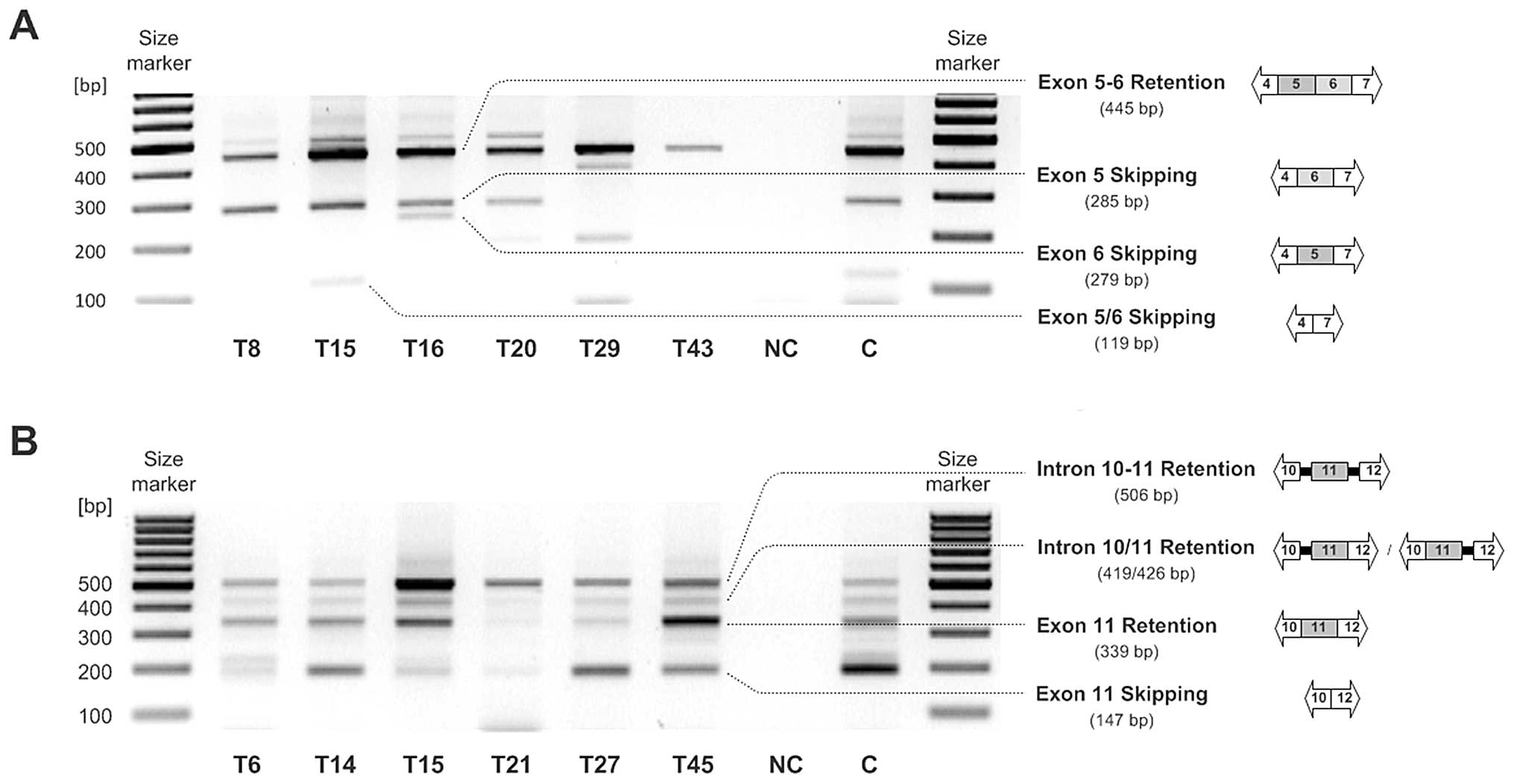|
1
|
Skotheim RI and Nees M: Alternative
splicing in cancer: Noise, functional, or systematic? Int J Biochem
Cell Biol. 39:1432–1449. 2007. View Article : Google Scholar : PubMed/NCBI
|
|
2
|
Tazi J, Bakkour N and Stamm S: Alternative
splicing and disease. Biochim Biophys Acta. 1792:14–26. 2009.
View Article : Google Scholar
|
|
3
|
Venables JP: Unbalanced alternative
splicing and its significance in cancer. BioEssays. 28:378–386.
2006. View Article : Google Scholar : PubMed/NCBI
|
|
4
|
Huiping C, Kristjansdottir S, Bergthorsson
JT, Jonasson JG, Magnusson J, Egilsson V and Ingvarsson S: High
frequency of LOH, MSI and abnormal expression of FHIT in gastric
cancer. Eur J Cancer. 38:728–735. 2002. View Article : Google Scholar : PubMed/NCBI
|
|
5
|
Cheung N, Wong MP, Yuen ST, Leung SY and
Chung LP: Tissue-specific expression pattern of vascular
endothelial growth factor isoforms in the malignant transformation
of lung and colon. Hum Pathol. 29:910–914. 1998. View Article : Google Scholar : PubMed/NCBI
|
|
6
|
Elias AP and Dias S: Microenvironment
changes (in pH) affect VEGF alternative splicing. Cancer
Microenviron. 1:131–139. 2008. View Article : Google Scholar
|
|
7
|
Hirschfeld M, Jaeger M, Buratti E, Stuani
C, Grueneisen J, Gitsch G and Stickeler E: Expression of
tumor-promoting Cyr61 is regulated by hTRA2-2401 and acidosis. Hum
Mol Genet. 20:2356–2365. 2011. View Article : Google Scholar : PubMed/NCBI
|
|
8
|
Krieg A, Mahotka C, Krieg T, Grabsch H,
Müller W, Takeno S, Suschek CV, Heydthausen M, Gabbert HE and
Gerharz CD: Expression of different survivin variants in gastric
carcinomas: First clues to a role of survivin-2b in tumour
progression. Br J Cancer. 86:737–743. 2002. View Article : Google Scholar : PubMed/NCBI
|
|
9
|
Vegran F, Boidot R, Oudin C, Riedinger JM
and Lizard-Nacol S: Distinct expression of Survivin splice variants
in breast carcinomas. Int J Oncol. 27:1151–1157. 2005.PubMed/NCBI
|
|
10
|
Eblen ST: Regulation of chemoresistance
via alternative messenger RNA splicing. Biochem Pharmacol.
83:1063–1072. 2012. View Article : Google Scholar : PubMed/NCBI
|
|
11
|
Ghigna C, De Toledo M, Bonomi S, Valacca
C, Gallo S, Apicella M, Eperon I, Tazi J and Biamonti G:
Pro-metastatic splicing of Ron proto-oncogene mRNA can be reversed:
Therapeutic potential of bifunctional oligonucleotides and indole
derivatives. RNA Biol. 7:495–503. 2010. View Article : Google Scholar : PubMed/NCBI
|
|
12
|
Collesi C, Santoro MM, Gaudino G and
Comoglio PM: A splicing variant of the RON transcript induces
constitutive tyrosine kinase activity and an invasive phenotype.
Mol Cell Biol. 16:5518–5526. 1996.PubMed/NCBI
|
|
13
|
Lu Y, Yao HP and Wang MH: Multiple
variants of the RON receptor tyrosine kinase: Biochemical
properties, tumorigenic activities, and potential drug targets.
Cancer Lett. 257:157–164. 2007. View Article : Google Scholar : PubMed/NCBI
|
|
14
|
Danilkovitch-Miagkova A: Oncogenic
signaling pathways activated by RON receptor tyrosine kinase. Curr
Cancer Drug Targets. 3:31–40. 2003. View Article : Google Scholar : PubMed/NCBI
|
|
15
|
Wang MH, Wang D and Chen YQ: Oncogenic and
invasive potentials of human macrophage-stimulating protein
receptor, the RON receptor tyrosine kinase. Carcinogenesis.
24:1291–1300. 2003. View Article : Google Scholar : PubMed/NCBI
|
|
16
|
Wang MH, Kurtz AL and Chen Y:
Identification of a novel splicing product of the RON receptor
tyrosine kinase in human colorectal carcinoma cells.
Carcinogenesis. 21:1507–1512. 2000. View Article : Google Scholar : PubMed/NCBI
|
|
17
|
Xu XM, Zhou YQ and Wang MH: Mechanisms of
cytoplasmic β-catenin accumulation and its involvement in
tumorigenic activities mediated by oncogenic splicing variant of
the receptor originated from Nantes tyrosine kinase. J Biol Chem.
280:25087–25094. 2005. View Article : Google Scholar : PubMed/NCBI
|
|
18
|
Zhou YQ, He C, Chen YQ, Wang D and Wang
MH: Altered expression of the RON receptor tyrosine kinase in
primary human colorectal adenocarcinomas: Generation of different
splicing RON variants and their oncogenic potential. Oncogene.
22:186–197. 2003. View Article : Google Scholar : PubMed/NCBI
|
|
19
|
Lynch HT, Casey MJ, Lynch J, White TE and
Godwin AK: Genetics and ovarian carcinoma. Semin Oncol. 25:265–280.
1998.PubMed/NCBI
|
|
20
|
Ferrandina G, Martinelli E, Petrillo M,
Prisco MG, Zucconi A, Santaguida S, Zannoni G, Scambia G and
Ferlini C: Prognostic role of the recepteur d’origine nantais (RON)
expression in ovarian cancer patients. Gynecol Oncol. 111:237–243.
2008. View Article : Google Scholar : PubMed/NCBI
|
|
21
|
Prislei S, Mariani M, Raspaglio G,
Mozzetti S, Filippetti F, Ferrandina G, Scambia G and Ferlini C:
RON and cisplatin resistance in ovarian cancer cell lines. Oncol
Res. 19:13–22. 2010. View Article : Google Scholar : PubMed/NCBI
|
|
22
|
Huang Y and Steitz JA: SRprises along a
messenger’s journey. Mol Cell. 17:613–615. 2005. View Article : Google Scholar : PubMed/NCBI
|
|
23
|
Zahler AM, Lane WS, Stolk JA and Roth MB:
SR proteins: A conserved family of pre-mRNA splicing factors. Genes
Dev. 6:837–847. 1992. View Article : Google Scholar : PubMed/NCBI
|
|
24
|
Fischer DC, Noack K, Runnebaum IB,
Watermann DO, Kieback DG, Stamm S and Stickeler E: Expression of
splicing factors in human ovarian cancer. Oncol Rep. 11:1085–1090.
2004.PubMed/NCBI
|
|
25
|
Stickeler E, Kittrell F, Medina D and
Berget SM: Stage-specific changes in SR splicing factors and
alternative splicing in mammary tumorigenesis. Oncogene.
18:3574–3582. 1999. View Article : Google Scholar : PubMed/NCBI
|
|
26
|
Fujii T, Seki N, Namoto-Matsubayashi R,
Takahashi H, Inoue Y, Toh U, Kage M and Shirouzu K: YB-1 prevents
apoptosis via the mTOR/STAT3 pathway in HER-2-overexpressing breast
cancer cells. Future Oncol. 5:153–156. 2009. View Article : Google Scholar : PubMed/NCBI
|
|
27
|
Kamura T, Yahata H, Amada S, Ogawa S,
Sonoda T, Kobayashi H, Mitsumoto M, Kohno K, Kuwano M and Nakano H:
Is nuclear expression of Y box-binding protein-1 a new prognostic
factor in ovarian serous adenocarcinoma? Cancer. 85:2450–2454.
1999. View Article : Google Scholar : PubMed/NCBI
|
|
28
|
Ghigna C, Giordano S, Shen H, Benvenuto F,
Castiglioni F, Comoglio PM, Green MR, Riva S and Biamonti G: Cell
motility is controlled by SF2/ASF through alternative splicing of
the Ron protooncogene. Mol Cell. 20:881–890. 2005. View Article : Google Scholar : PubMed/NCBI
|
|
29
|
Maggiora P, Lorenzato A, Fracchioli S,
Costa B, Castagnaro M, Arisio R, Katsaros D, Massobrio M, Comoglio
PM and Flavia Di Renzo M: The RON and MET oncogenes are
co-expressed in human ovarian carcinomas and cooperate in
activating invasiveness. Exp Cell Res. 288:382–389. 2003.
View Article : Google Scholar : PubMed/NCBI
|
|
30
|
Wang MH, Yao HP and Zhou YQ: Oncogenesis
of RON receptor tyrosine kinase: A molecular target for malignant
epithelial cancers. Acta Pharmacol Sin. 27:641–650. 2006.
View Article : Google Scholar : PubMed/NCBI
|
|
31
|
Camp ER, Liu W, Fan F, Yang A, Somcio R
and Ellis LM: RON, a tyrosine kinase receptor involved in tumor
progression and metastasis. Ann Surg Oncol. 12:273–281. 2005.
View Article : Google Scholar : PubMed/NCBI
|
|
32
|
Chen YQ, Zhou YQ, Angeloni D, Kurtz AL,
Qiang XZ and Wang MH: Overexpression and activation of the RON
receptor tyrosine kinase in a panel of human colorectal carcinoma
cell lines. Exp Cell Res. 261:229–238. 2000. View Article : Google Scholar : PubMed/NCBI
|
|
33
|
Ma Q, Zhang K, Guin S, Zhou YQ and Wang
MH: Deletion or insertion in the first
immunoglobulin-plexin-transcription (IPT) domain differentially
regulates expression and tumorigenic activities of RON receptor
tyrosine kinase. Mol Cancer. 9:3072010. View Article : Google Scholar : PubMed/NCBI
|
















